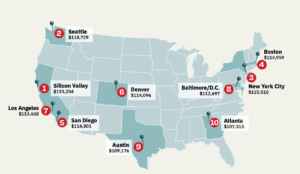
Salaries Climbed in 2021, But ML and AI Paid Less, Dice Reports

Compensation for tech workers kept up with inflation last year (but didn’t exceed it) with an average salary increase of nearly 7% according to the latest Dice Tech Salary Report. Database admins, support engineers, and data analysts led the way in data-related gains, while demand (and salaries) softened a bit for folks with data science, machine learning, and AI skills.
At $104,566, the average tech salary reached six figures for the first time ever, according to the latest Dice Tech Salary Report. Silicon Valley remained a tech hotbed with an average salary of $133,204, followed by Seattle, Washington and New York City.
C-level tech leaders and IT management had the highest average salary in 2021, at nearly $152,000. But it was the humble database administrator turning in one of the biggest one-year gains, with a 12.4% increase to about $111,000. Technical support engineers also logged a 12.4% increase to a hair above $77,000, while salaries for data analysts ticked up 11.5% to nearly $85,000. Those classified as business analyst/intelligence analyst saw a 4.0% increase to $101,500.
Developers were in hot demand last year, particularly Web developers, which saw a 21.3% increase in salary to nearly $99,000. The humble software developer saw a solid 8.0% increase in pay to about $120,000, while the average UX/UI designer saw a 10% raise to $101,000, Dice reports.
Several data-related jobs didn’t do so well. Data engineers saw their average salary drop by 1.1% to about $117,000, while data scientists saw a scant 0.6% increase to just under $121,000. Data architects saw their average salary decrease by 3.2% to slightly less than $129,000.
Dice noted: “These professions generally earn high salaries, hinting at their value to organizations large and small — so what’s behind the conspicuous lack of a year-over-year salary bump?,” the company wrote in its report. “One possibility could be that salaries in 2021 for these roles are lagging indicators, and that these high-growth and high-value occupations will begin to see an uptick in early 2022 and throughout the year. It could also have something to do with the proliferation of tools designed to carry out some of these roles’ highly specialized functions.”
Several other interesting trends emerged when slicing the salaries by specific skills, as opposed occupation. Demand for Solr spiked, with an average salary of more than $143,000, a nearly 16% increase from 2020, Dice says. Demand was also strong for Elasticsearch (6.0% gain to about $137,000), Amazon RDS (10.9% to nearly $134,000) and Hana (6.7% gain to slightly more than $133,000).
Curiously, several high-growth areas saw some regression in salaries. Those with machine learning skills saw a 2.1% drop in average salary to nearly $123,000, while natural language processing was down 7.8% to about $121,000 and the catch-all “artificial intelligence” saw an 8.9% drop to about $120,000. Over a two-year period, machine learning salaries have grown a 1.0%, NLP salaries are down 3.4%, and AI salaries are down 2.3%.
Several related AI technologies saw little change in average salary, per Dice, including neural networks, which went up 1.5% to about $131,000 and TensorFlow, which went up a scant 0.1% to $139,000. Hadoop (anybody remember Hadoop?) held its own, with a 0.4% increase in average salary to $130,000. However, Cloudera as a skill was associated with a 5.7% drop in salary to about $124,500, and MapReduce decreased 2.6% to $132,000. Spark saw a 3.1% increase to about $128,000.
Related Items:
Battle for Data Pros Heats Up as Burnout Builds
Hiring Outlook Bright for Data and Open Source Pros
Data and AI Salaries Continue Upward March, O’Reilly Says
































